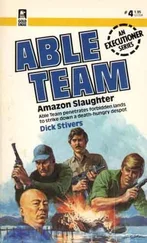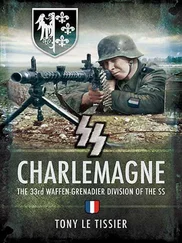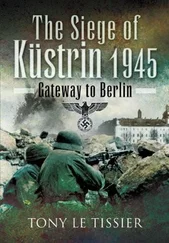Beyond the junction of the road to Teupitz, near the village church, the leading tank came up against a barrier, originally erected against Soviet tanks, that consisted of two rows of pine logs rammed into the earth with the space in between filled with sand. This barrier extended right across the road, forming a formidable obstacle to further progress. The pressure from behind immediately formed a blockage at this point. A witness, the driver of one of the leading tanks, described what happened next:
At once, all broke loose! Shells were exploding all around, not only high explosive, but phosphor shells too. It seemed that the Russians had long since identified 9th Army’s break-out point through air reconnaissance and prepared a trap for us in Halbe. All the buildings around us were hit and caught fire, illuminating the scene in ghostly fashion. I then spotted two Russian tanks behind the anti-tank barrier. The Russian fire was becoming increasingly strong and driving over the barricade looked suicidal to me. [18] Lakowski/Stich, Der Kessel von Halbe 1945 , p. 119.
The Soviet fire hindered every manoeuvre, and the two leading tanks were lost, as will be described shortly. Eventually the tanks managed to bypass Halbe and reached the autobahn at daybreak.
The town itself, into which ever more people and vehicles were pushing, was surrounded on three sides and had the fire of 1st Guards Artillery Breakthrough Division directed on it. A massive barrage using five artillery brigades had been planned against this breakthrough sector, starting with a five-minute all-out bombardment and going on to ten minutes of methodical fire, for which the firing of 1,000 shells per minute had been planned. [19] Domank, The 1st Guards Breakthrough Artillery Division at Halbe’.
A second anti-tank barrier, several hundred metres beyond the church on the road to Teurow, blocked the progress of another group for hours. This road, which had been shot up by German rocket launchers, presented the same horrific picture as the other breakthrough sectors with the dead lying on top of each other, people crushed to death by the tanks, and wounded crying out for help. There was no differentiation between civilians and soldiers in this mêlée. [20] Lakowski/Stich, Der Kessel von Halbe 1945 , pp. 108–18.
In and around Halbe, the various groups, no longer under proper control, sought to break through the Soviet positions and reach the shelter of the woods. Many units tried to bypass Halbe rather than go through it. SS-Captain Paul Krauss of 32nd SS Tank-Hunting Battalion was with the remains of his unit in the woods north-east of the village, where they destroyed all the remaining wheeled vehicles. He then went forward with his liaison officer, SS-Second Lieutenant van Hogen, to reconnoitre the route, leaving SS-Lieutenant Schnur to follow with the main body twenty minutes later. Krauss recorded:
Van Hogen and I came to a copse that was full of German soldiers and civilians. In front of us was Halbe railway station, which was occupied by the Russians, who were firing at our copse with machine guns and mortars. The cries of the wounded and dying were coming from all around, and something had to be done as quickly as possible. While van Hogen went back to fetch our men, I gathered some officers and NCOs around me, explained the situation and told them that I was taking command and that, as soon as my men arrived, we would break through. Whoever wanted to could join us.
We waited for van Hogen and the rest of the Supply Company in vain. Instead we heard the sounds of fighting coming from their direction. Now 9th Army’s general break-out appeared to be in full swing. We could not wait any longer, so I charged the red-brick buildings of the station shouting: ‘Forward, grenadiers, forward!’
Some 300 followed me, soldiers and civilians, including women and children. Our fearful cries and firing hit the Russians like an apocalypse, and they fled from the station buildings. We charged right across the railway embankment and reached a copse on the far side. Those who fell, or were wounded, were left behind.
We came to a sunken track that was about two metres deep and two hundred metres long. The whole wood was under constant fire from the Russian artillery and mortars. There were dead and wounded lying everywhere, soldiers and civilians. My mob scattered here, with individuals and small groups all heading west. Cohesion had collapsed, the mass refusing to be led any longer. All discipline had disappeared. [21] Tieke, Das Ende zwischen Oder und Elbe , pp. 319, 321.
SS-Colonel Kempin reported that many officers and NCOs had removed the epaulettes bearing their rank insignia in rejection of any further disciplinary responsibility. [22] Ibid .
The progress of the southern wedge was described in some detail by Rudi Lindner, then an officer cadet with the 1241st Grenadier Regiment, which by then had been reduced to company strength:
We paraded with the 9th Army’s southern armoured spearhead, which consisted of 14 Tiger tanks, assault guns, APCs and motor vehicles, arranged as follows:
• The vanguard, consisting of 2nd Company, 502nd SS Heavy Panzer Battalion;
• The remains of 1241st Grenadier Regiment as close infantry escort for the tanks;
• Part of an APC company of the Kurmark ;
• The Reconnaissance and Pioneer Platoon of the 502nd;
• 1st Company, 502nd, with the battalion commander and signals officers, and a mortar battery;
• The remainder of the 502nd with a self-propelled four-barrelled anti-aircraft gun, motorcycles, ambulance and medical officer.
This day, 28 April, which began so calmly as we were detailed off as tank escorts to the armoured columns, and ended so tragically, will always remain in my memory. We did not know then that we were preparing for a journey into hell and that for most of us it would be our death. Our platoon, now made up of one officer and 15 grenadiers, was assigned to the leading Tiger tanks of the spearhead, whose platoon commander was SS-Second Lieutenant Kuhnke.
I found myself on the second tank, commanded by SS-Sergeant-Major Ernst Streng, and with SS-Sergeant Ott as the driver. We fastened ourselves on to the tank mountings with our belts and equipment straps, so that we would have our hands free for firing our rifles and Panzerfausts, and for throwing grenades.
At about 1800 hours on 28 April, the heavy weapons fired a barrage on Halbe, after which the guns were blown up. Then at about 1830 hours our armoured column moved out of the assembly area towards Märkisch Buchholz and Halbe. We thrust through Märkisch Buchholz without encountering any significant resistance, then moved along a woodland track towards Halbe. The northern armoured spearhead of the Panzergrenadier Division Kurmark was also rolling along another woodland track towards Halbe. Short halts for observation and reconnaissance delayed our advance.
A Russian anti-tank barrier in front of Halbe caused the first big delay. A mortar battery went into action and fired a salvo on the resistance nests on the eastern edge of Halbe, while our leading tank platoon engaged the barrier. The Russian security forces then pulled back into Halbe village. Our armoured vanguard was then ordered to push on into Halbe, and our Tiger tanks set off again. We drove into the village south of the railway station, reaching a straight street lined with trees, where the back gardens of the first houses lay.
We thought that here, too, we would encounter only minor resistance, but with a blast all hell broke loose. We had driven into an ambush.
At this point I should mention that following us in the woods to the right and left of our armoured column, if a little further back, was a stream of soldiers and refugees, who kept closing up to us whenever we stopped. In their fear of losing contact and becoming prisoners of the Russians, but also because of non-existent or insufficient combat experience, most of the soldiers were conducting themselves in a totally unmilitary fashion, so that unfortunately very many of them had to pay with their lives for it. For instance, behind each tank in Halbe there was a cluster of some forty to sixty people seeking shelter, and every time we stopped the numbers increased. In addition, many soldiers were unarmed, and most of the soldiers who were armed did not or were unable to use their weapons. In practice, only the leading tank could fire forward, while we grenadiers sitting on top fired obliquely into the roofs and windows.
Читать дальше












